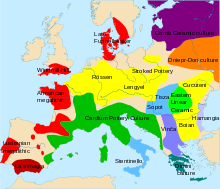 | |
| Horizon | Old Europe |
|---|---|
| Geographical range | Central Europe |
| Period | Neolithic, Chalcolithic |
| Dates | c. 5000 BC — c. 4000 BC |
| Major sites | Lengyel |
| Preceded by | Linear Pottery culture, Tisza culture |
| Followed by | Funnelbeaker culture, Baden culture, Globular Amphora culture |

The Lengyel culture is an archaeological culture of the European Neolithic, centered on the Middle Danube in Central Europe. It flourished from 5000 to 4000 BC, ending with phase IV, e.g., in Bohemia represented by the 'Jordanow/Jordansmühler culture'. It is followed by the Funnelbeaker culture/TrB culture[1] and the Baden culture. The eponymous type site is at Lengyel in Tolna county, Hungary.
It was preceded by the Linear Pottery culture and succeeded by the Corded Ware culture. In its northern extent, overlapped the somewhat later but otherwise approximately contemporaneous Funnelbeaker culture. Also closely related are the Stroke-ornamented ware and Rössen cultures, adjacent to the north and west, respectively.
Subgroups of the Lengyel horizon include the Austrian/Moravian Painted Ware I and II, Aichbühl, Jordanów/Jordanov/Jordansmühl, Schussenried, Gatersleben, etc.
It is a wide interaction sphere or cultural horizon rather than an archaeological culture in the narrow sense. Its distribution overlaps with the Tisza culture and with Stroke-Ornamented Pottery (STK) as far north as Osłonki, central Poland.
Lengyel pottery was found in western Hungary, the Czech Republic, Slovakia, Austria, Poland, and Slovenia. Several Sopot culture finds in Croatia and Hungary were dated to the same general periods as the Lengyel culture finds. Influence in pottery styles is found even further afield, in parts of Germany and Switzerland.
Agriculture and stock raising (mainly cattle, but also pigs, and to a lesser extent, ovicaprids) was practiced, though many wild faunal remains have also been recovered. Settlements consisted of small houses as well as trapezoid longhouses. These settlements were sometimes open, sometimes surrounded by a defensive ditch.
Inhumation was in separate cemeteries, in the flexed position with apparently no preference for which side the deceased was laid out in.
Lengyel sites of the later period show signs of the use of copper in form of beads and hammered ribbons, marking the dawn of the Chalcolithic period in Central Europe.
It was associated with the cover-term Old Europe by Marija Gimbutas, though may have been undergone "kurganization" by the Proto-Indo-Europeans and become integrated into the successor Globular Amphora culture. According to archaeogenetic studies, its population had no or negligible amount of Indo-European steppe ancestry.
YouTube Encyclopedic
-
1/5Views:2 5141 6026814491 813
-
Neolithic cultures of Europe: early and late (Pre-historic archaeology)
-
The Gods Descend
-
NOT ONLY JADE: LONG-SCALE CONNECTIONS REVEALED BY THE NEOLITHIC POLISHED STONE AXESOF CAPUT ADRIAE
-
Kurgan culture | Wikipedia audio article
-
Caucasus Hunter Gatherers & Yamnaya Culture
Transcription
Archaeogenetics
Lipson et al. (2017), Narasimshan et al. (2019) and Patterson et al. (2022) detected in nine individuals from Hungary ascribed to the Lengyel culture the Y-Haplogroups H, H-P96, I2a2a-S6635, I2a1a1b-S21825, G2a2a1-PF3148, J2a1a2b-Z6055, C1a2-V86, and E1b1b1a1b1-L618. mtDNA extracted were various subclades of U8b1a2b, N1a1a, T2b, H and H44, J1c, W1.[2][3][4] According to ADMIXTURE analysis they had approximately 85-98% Early European Farmers, 4-12% Western Hunter-Gatherer and 0-3% Western Steppe Herders-related ancestry.[4]
Gallery
-
Lengyel painted pottery sherds
-
Lengyel pottery.[5]
-
Lengyel pottery
-
Lengyel pottery
-
Burial with copper items, Oslonki, Poland, 4100 BC
-
Copper axe, Poland, c. 4000 BC
-
Pottery
-
-
Falkenstein venus figurine
-
Wetzleinsdorf venus figurine
-
Modern sculpture of a figurine found at Nitriansky Hradok
-
Ölkam venus, Austria, c. 4500 BC
-
-
House model
Jordanów culture
-
Ram sculpture, Poland
-
-
Jordanow pottery
-
Pottery
-
-
Stollhof hoard
-
Gold disc[8]
See also
- Circular Enclosures
- Cucuteni culture
- Vinca culture
- Yamna culture
- Prehistoric Europe
- Old Europe (archaeology)
References
- ^ Mallory, James P.; Adams, Douglas Q., eds. (1997). Encyclopedia of Indo-European Culture. Fitzroy Dearborn Publishers. pp. 349–50. ISBN 1884964982.
- ^ Lipson 2017.
- ^ Narasimhan 2019.
- ^ a b Patterson, Isakov & Booth 2022.
- ^ "Lengyel pottery".
- ^ Siklósi, Z.; Horváth, E.; Villa, I. M.; Nisi, S.; Mozgai, V.; Bajnóczi, B.; Csippán, P.; Hornok, P.; Kiss, P. (2022). "The provenance of the raw material and the manufacturing technology of copper artefacts from the Copper Age hoard from Magyaregres, Hungary". PLOS ONE. 17 (11): e0278116. Bibcode:2022PLoSO..1778116S. doi:10.1371/journal.pone.0278116. PMC 9683617. PMID 36417420.
- ^ "Stollhof Hoard". Google Arts & Culture - Natural History Museum Vienna.
- ^ "Gold disc". Landesmuseum Württemberg.
Sources
- Bánffy, Eszter (1997). Cult Objects of the Neolithic Lengyel Culture: Connections and Interpretation. David Brown Book Co. ISBN 9789638046161.
- Lipson, Mark (November 16, 2017). "Parallel palaeogenomic transects reveal complex genetic history of early European farmers". Nature. Nature Research. 551 (7680): 368–372. Bibcode:2017Natur.551..368L. doi:10.1038/nature24476. PMC 5973800. PMID 29144465.
- Narasimhan, Vagheesh M. (September 6, 2019). "The formation of human populations in South and Central Asia". Science. American Association for the Advancement of Science. 365 (6457): eaat7487. bioRxiv 10.1101/292581. doi:10.1126/science.aat7487. PMC 6822619. PMID 31488661.
- Patterson, Nick; et al. (2022). "Large-scale migration into Britain during the Middle to Late Bronze Age" (PDF). Nature. 601 (7894): 588–594. Bibcode:2022Natur.601..588P. doi:10.1038/s41586-021-04287-4. PMC 8889665. PMID 34937049. S2CID 245509501.
External links
- The Lengyel Culture Sphere by Maximilian O. Baldia
- All things bright: copper grave goods and diet at the Neolithic site of Osłonki, Poland (Budd et al. 2020)
- A Jordanow culture copper pectoral
- Eneolithic gold disc
- The orientation of rondels of the Neolithic Lengyel culture in Central Europe


![Lengyel pottery.[5]](/wikipedia/commons/thumb/7/7a/Museum_Quintana_-_Lengyelkultur_Gef%C3%A4%C3%9F.jpg/100px-Museum_Quintana_-_Lengyelkultur_Gef%C3%A4%C3%9F.jpg)















![Stollhof Hoard, Austria, c. 4000 BC.[6][7]](/wikipedia/commons/thumb/b/bb/Stollhof_Hoard_02.JPG/120px-Stollhof_Hoard_02.JPG)

![Gold disc[8]](/wikipedia/commons/thumb/1/15/Gold_disc_1.jpg/118px-Gold_disc_1.jpg)